
Wicker baskets offer durable, natural ventilation and a rustic aesthetic perfect for storing items that benefit from airflow, while fabric baskets provide lightweight flexibility and a variety of patterns ideal for organizing soft goods and adding color to your space. Explore the rest of the article to discover which basket type best suits your storage needs and style preferences.
Table of Comparison
| Feature | Wicker Basket | Fabric Basket |
|---|---|---|
| Material | Natural woven fibers (rattan, willow) | Cloth (cotton, canvas, polyester) |
| Durability | Sturdy but can crack or splinter | Flexible, resists tears but can wear out |
| Weight | Light to medium weight | Lightweight and easy to carry |
| Breathability | Good air circulation | Variable, depends on fabric type |
| Design | Rustic, natural aesthetic | Variety of colors and patterns |
| Maintenance | Wipe clean, can be sensitive to moisture | Machine washable or spot clean |
| Use Cases | Decorative storage, picnic baskets | Closet organization, laundry, toys |
| Cost | Generally higher due to material | Generally affordable and budget-friendly |
Introduction to Wicker and Fabric Baskets
Wicker baskets, crafted from natural materials like rattan, willow, or bamboo, offer durability and rustic charm ideal for both decorative and practical uses. Fabric baskets, made from cotton, linen, or synthetic textiles, provide lightweight flexibility with soft textures perfect for delicate items or spaces that require a more casual aesthetic. Your choice between wicker and fabric baskets depends on the balance of sturdiness and softness needed for your storage or decor needs.
Material Composition and Durability
Wicker baskets are crafted from natural materials like rattan, bamboo, or willow, offering sturdy construction that withstands daily wear and tear, ideal for long-term use. Fabric baskets, made from cotton, polyester, or canvas, provide lightweight flexibility but may wear out faster due to exposure to moisture and frequent handling. Your choice depends on whether you prioritize the rugged durability of wicker or the soft, collapsible convenience of fabric.
Aesthetic Appeal and Design Options
Wicker baskets offer a rustic and natural aesthetic that enhances farmhouse, boho, and vintage interior designs, while fabric baskets provide a softer, more versatile look with a wide range of colors, patterns, and textures to complement modern and minimalist styles. Wicker baskets feature intricate weaving patterns and organic textures that add warmth and character, whereas fabric baskets allow for customization in shape, size, and fabric type, including canvas, cotton, or felt. Both options serve decorative and functional purposes, but fabric baskets excel in adaptability and color variety, making them ideal for personalized home decor schemes.
Weight and Portability Comparison
Wicker baskets are generally heavier due to their sturdy, woven natural materials, making them less convenient for frequent carrying compared to fabric baskets. Fabric baskets, made from lightweight materials like cotton or polyester, offer superior portability and are easier to fold or pack when not in use. Your choice depends on whether you prioritize durability with a bit of weight or lightweight convenience for transport.
Storage Capacity and Versatility
Wicker baskets typically offer a rigid structure that supports larger storage capacity for bulky or heavy items, making them ideal for organizing spaces that require durability and shape retention. Fabric baskets provide superior versatility with flexible materials that can easily adapt to different shapes and fold flat for convenient storage when not in use. Your choice hinges on the need for sturdy, spacious storage versus adaptable, lightweight options for varied uses.
Maintenance and Cleaning Requirements
Wicker baskets require regular dusting and occasional wiping with a damp cloth to prevent dirt buildup and maintain their natural look, while fabric baskets often need machine washing or spot cleaning depending on the material. Wicker is more susceptible to moisture damage, making it important to keep dry and avoid prolonged exposure to humidity. Your choice should consider how much time you're willing to invest in maintenance and cleaning to keep the basket looking its best.
Environmental Impact and Sustainability
Wicker baskets, made from natural, renewable materials like rattan or willow, offer a biodegradable option with minimal environmental impact and can be sustainably harvested when sourced responsibly. Fabric baskets, often crafted from cotton or synthetic fibers, may have a higher environmental footprint due to water-intensive cultivation of cotton or the non-biodegradable nature of synthetic fabrics, though organic or recycled fabrics improve sustainability. Your choice should consider the lifecycle impact, with wicker baskets generally providing eco-friendliness through durability and natural decomposition.
Price Range and Value for Money
Wicker baskets typically range from $20 to $100 depending on size and craftsmanship, offering durable and eco-friendly storage that ages well over time. Fabric baskets are generally more affordable, priced between $10 and $50, providing lightweight, flexible options ideal for easy handling and varied designs. Your choice depends on whether you prioritize long-term durability and natural aesthetics or budget-friendly, versatile storage solutions.
Best Uses for Wicker Baskets
Wicker baskets excel in organizing household items, storing blankets, or displaying decorative pieces due to their sturdy structure and natural aesthetic. Their breathable material prevents moisture buildup, making them ideal for laundry or fruit storage. Wicker baskets also enhance rustic or bohemian interiors, providing both functionality and charm.
Best Uses for Fabric Baskets
Fabric baskets excel in organizing soft items such as clothing, toys, and linens due to their lightweight and flexible structure, making them ideal for nursery storage, laundry rooms, and closets. Their breathable materials prevent moisture buildup, preserving delicate fabrics and reducing odors, which is perfect for storing seasonal garments or accessories. These baskets also offer easy portability with handles and foldability for compact storage when not in use, enhancing functionality in small living spaces.
 homyna.com
homyna.com